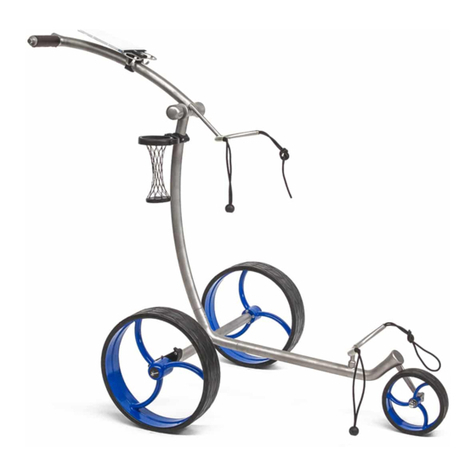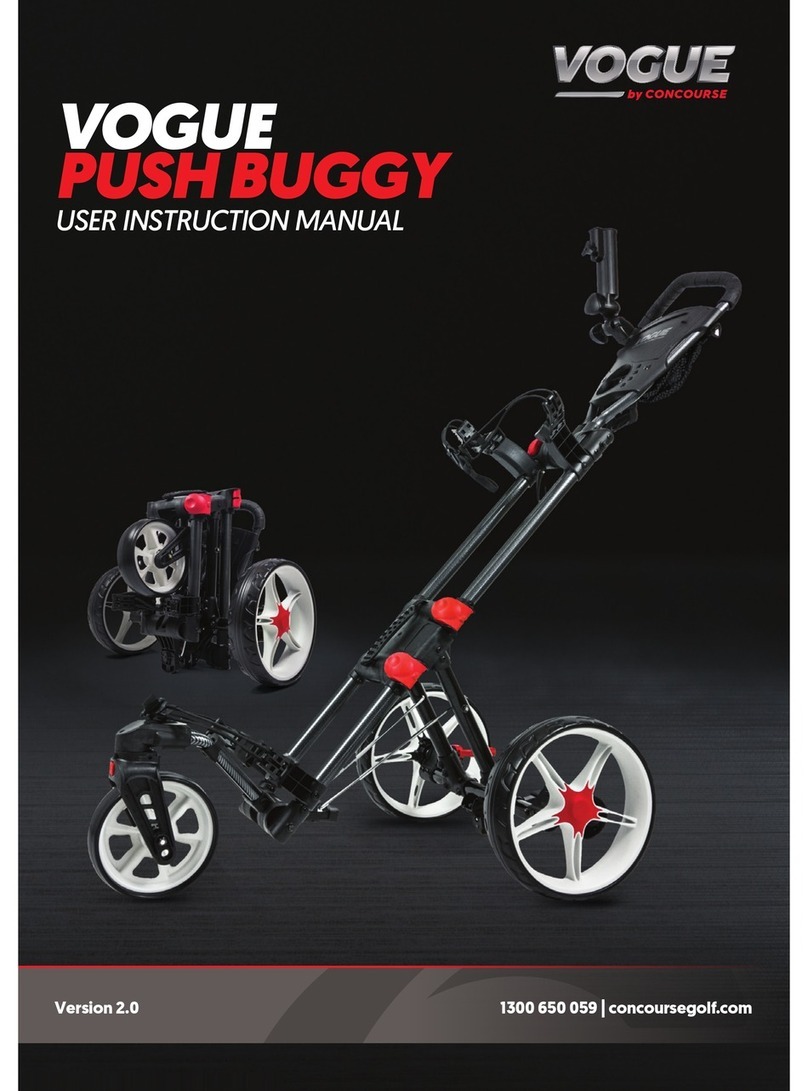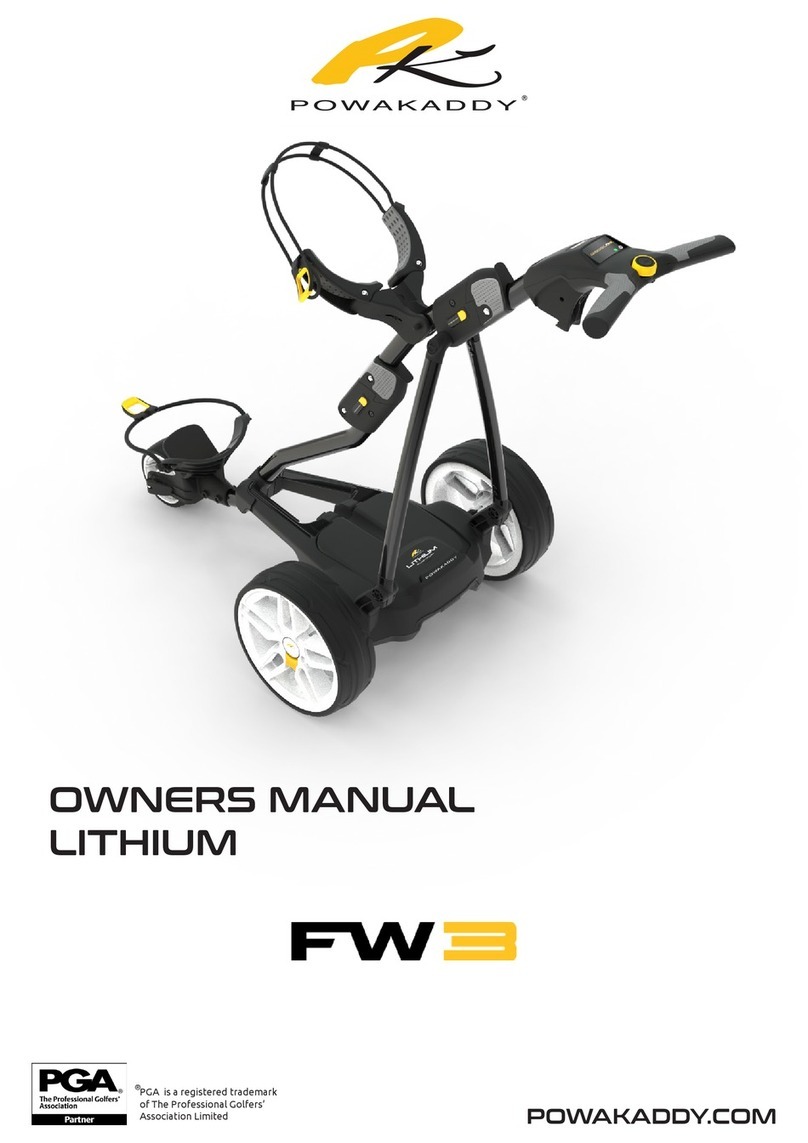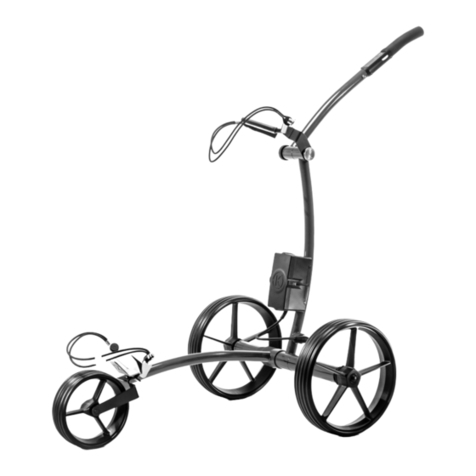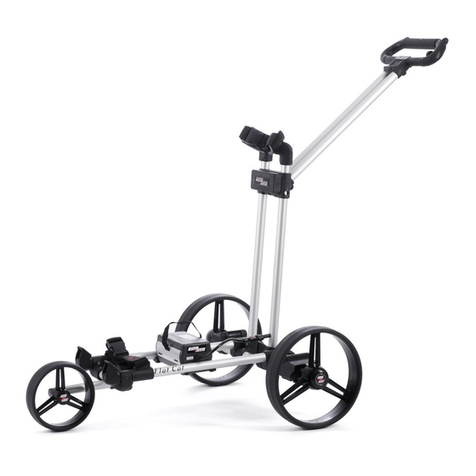Golfomania Genius User manual

Genius – Titan Golf Trolley
Bedienungsanleitung
Manuel d’utilisation
Manuale d’uso
User manual

Genius – Titan Golf Trolley
Elektrotrolley mit Lithium-Batterie
Inhalt und Bestandteile
■Transporttasche mit separatem Räderfach
■2 Antriebsräder
■Längsachse mit Vorderrad
■Antriebsachse mit Doppelrohrmotor
■ Faltbarer Caddyrahmen mit Steuergri und Bedienungseinheit
■Scorecardhalter mit Schrauben und Inbusschlüssel
■ Schirmhalter mit Befestigungsschraube
■Getränkehalter
■ Lithium-Ionen-Akku 10 Ah (Batterie) mit Halterung
■Ladegerät
■Ersatzdichtungen
■ Schlüssel zum einfachen Lösen der Steckverbindungen (T-Tool)
■ Achsenschutz (mit Gummiband verbunden)
■ Bedienungsanleitung mit Ersatz-O-Ringen
3

Zusammenfügen des Trolleys:
■Zusammenfügen von Längsachse und Antriebsachse
(Abb. 1).
■Einsetzen der Antriebsräder: dabei Stift an Radnabe
eindrücken und Rad einrasten (Abb. 2).
Achtung: Erste Einraststufe = Freilaufmodus
(leichtgängiger manueller Betrieb).
Zweite Einraststufe = Motorbetrieb.
Stellen Sie sicher, dass die Räder korrekt (hörbar)
eingerastet sind. Das Prol der Pneus soll in die
Laufrichtung zeigen (wie Vorderrad) (Abb. 2).
■Steuerarm einsetzen und auf persönliche
Höhe einstellen (Abb. 3).
■ Baghalterung unten: hochziehen und in Fahrt-
richtung drehen.
■ Baghalterung oben: in der gewünschten Position
einrasten und xieren.
■ Batterie in Halterung einsetzen und Kabel einstecken
(Abb. 4). Die LED-Lämpchen zeigen Ihnen den aktuellen
Ladestand an (5 LEDs = voll).
■ Scorecardhalter: mit Befestigungsbride an Caddy-
rahmen festschrauben. Schrauben mit Inbusschlüssel
festziehen (Abb. 5).
■ Schirmhalter: am Handgri mit der dazugehörigen
Feststellschraube in der gewünschten Position
xieren (Abb. 6). Das Gummiband dient zur Sicherung
des Schirms bei Wind.
■Getränkehalter: an Caddyrahmen festschrauben.
Schrauben mit Inbusschlüssel festziehen (Abb. 7+ 8).
■ Golfbag aufsetzen und an beiden Halterungen
mittels Gummiband befestigen.
Erste Inbetriebnahme
4
1
2
3
4
5678

Einstellen Geradeauslauf
Bei einer allfälligen Abweichung vom Geradeauslauf
kann dies ganz einfach justiert werden:
1. Lösen Sie die Radmutter leicht auf der linken Seite
(in Fahrtrichtung).
2. Durch Drehen der zwei kleinen Inbusschrauben auf
der Vorder- und Rückseite der Radaufhängung kann
die Position des Rades justiert werden.
3. Nach erfolgter Justierung die Radmutter anziehen.
5
Sicherheitshinweise
■Laden Sie den Akku nur mit dem dafür vorgesehenen Ladegerät. Die Verwendung
eines nicht zugelassenen Ladegeräts kann für den Akku zu folgenschweren
Beschädigungen führen.
■ Bewahren Sie den Akku an einem trockenen Ort auf und vermeiden Sie extreme
Temperaturen.
■ Bei langer Nichtbenutzung (über 3 Monate) unbedingt Zwischenladung vornehmen.
Laden und Warten der Batterie
Wichtig: Laden Sie die Batterie beim ersten Mal
ununterbrochen während mindestens 6 Stunden.
■Rotes Lämpchen = Akku wird geladen
■Grünes Lämpchen = kein Ladevorgang oder Lade-
vorgang beendet. Bitte entfernen Sie das Ladekabel
nach dem Ladevorgang aus der Stromsteckdose.
LED-Ladestandsanzeige im Batteriegehäuse:
Wenn der Batteriestecker am Trolley eingesteckt ist,
leuchtet die LED-Anzeige grün.
■5 LEDs = volle Ladung (Abb.)
■1 LED = minimale Ladung
■ Laden Sie die Batterie nach jeder Golfrunde wieder komplett auf, auch wenn noch
genügend Restladung für einen weiteren Einsatz vorhanden wäre. Gehen Sie nur
mit voll aufgeladener Batterie auf die Golfrunde.
■ Lagern Sie die Batterie liegend an einem warmen Ort. Nach dem Ladevorgang Batterie
vom Netz nehmen. Wichtig: Lagern Sie die Batterie immer in aufgeladenem Zustand.
■ Nach längerer Nichtbenutzung, z. B. nach der Winterpause, schliessen Sie die Batterie
nochmals ans Netz an und wiederholen die Auadung. Ist die Pause länger als
3 Monate, führen Sie unbedingt eine Zwischenladung durch.
■ Bitte verwenden Sie ausschliesslich das mitgelieferte Ladegerät.

■LED-Anzeige:
■ Kein Licht = kein Strom/Batterie nicht eingesteckt
■ Langsames Blinken = zu geringe Spannung,
Akku laden!
■ Schnelles unregelmässiges Blinken = Standby,
Parkbremse aktiv
■Start: Knopf A drücken. Der Trolley fährt in der
letztmals gewählten Geschwindigkeit.
■Stopp: Knopf A drücken. Die automatische Parkbremse verhindert ein Weiterrollen.
■Parkbremse lösen (zum manuellen Verschieben des Trolleys): Drehregler auf null
zurückdrehen und die Start-Stopp-Taste drücken.
■Bremse abermals aktivieren: Drücken der Start-Stopp-Taste.
■Distanztimer (mit dieser Funktion können Sie den Trolley 10 oder 20 Meter
weiterfahren lassen):
■ Bei Stillstand Knopf B 3 Sek. drücken, bis LED-Anzeige schnell blinkt, dann loslassen.
Trolley fährt 10 Meter in der eingestellten Geschwindigkeit.
■ Bei Stillstand Knopf B mind. 5 Sek. drücken, bis LED-Anzeige langsam blinkt, dann
loslassen. Trolley fährt 20 Meter in der eingestellten Geschwindigkeit.
■Geschwindigkeit einstellen: Durch Drehen des Potentiometers (Rädchen C)
können Sie die Geschwindigkeit stufenlos einstellen.
■Drehen in Laufrichtung = schneller
■Drehen rückwärts = langsamer
Reinigung/Pege/Lagerung
■ Reinigen Sie den Trolley am besten mit einem feuchten Tuch und/oder Druckluft.
Vermeiden Sie das Abspritzen mit Wasser.
■Lagern Sie Ihren Trolley immer in trockenen Räumen.
6
Bedienung
■ Halten Sie Ihren Trolley unter Kontrolle: Lassen Sie Ihre Hand während der Fahrt
immer am Gri, damit Sie bei Bedarf rechtzeitig stoppen oder ausweichen können.
■Stellen Sie den Trolley in steilem Gelände immer quer zum Gefälle ab, um ein
selbständiges Losrollen oder -rutschen zu verhindern.
■Achten Sie beim Durchqueren von Wasserhindernissen darauf, dass die Motorachse
nicht eintaucht. Sollte Wasser in die Achse eindringen, können Motoren und
Elektronik Schaden nehmen.
C
B
A
LED

7
Transport
■ Bitte benutzen Sie für den Transport die Transporttasche. Diese hat unten ein Fach
für die Hinterräder und im oberen Stauraum Unterteilungen für 3 Fächer. Um
Beschädigungen beim Transport zu vermeiden (z. B. Kratzer), legen Sie die Motorachse,
den Steuerarm und die Vorderachse mit Rad jeweils in ein separates Abteil.
■Achtung: Der Reissverschluss des Radfaches soll nur geönet und geschlossen werden,
wenn das darüber liegende Fach leer ist, er könnte sonst reissen.

Genius – Titan Golf Trolley
Caddy de golf électrique avec batterie lithium
Contenu et pièces
■Sac de transport avec compartiment séparé pour les roues
■2 roues motrices
■ Axe longitudinal avec roue avant
■ Axe d’entraînement avec deux moteurs tubulaires
■Cadre pliable avec poignée de commande et unité de commande
■Support de carte de score avec vis et clé Allen
■ Support de parapluie avec vis de xation
■Support de boissons
■ Batterie lithium-ion 10 Ah avec support
■Chargeur
■Joints de remplacement
■ Clés de desserrage rapide des connecteurs (T-tool)
■ Protection d’axes (reliées par un cordon en caoutchouc)
■ Manuel d’utilisation avec joints toriques de rechange
8

9
Assemblage du caddy:
■ Assemblage de l’axe longitudinal et de l’axe
d’entraînement (ill. 1).
■
Mise en place des roues motrices: glisser le moyeu de
la roue sur l’axe et appuyer pour l’enclencher (ill. 2).
Attention: 1er niveau d’enclenchement = mode roue
libre (utilisation manuelle plus souple). 2eniveau
d’enclenchement = mode motorisé. S’assurer que
les deux roues sont correctement enclenchées
(«clic» audible). Le prol des pneus doit être dans
le sens de la marche (comme la roue avant) (ill. 2).
■
Fixer le bras de commande et ajuster la hauteur (ill. 3).
■ Partie inférieure de la xation de sac: soulever et
tourner dans le sens de la marche.
■ Partie supérieure de la xation de sac: enclencher
dans la position souhaitée et xer.
■ Fixer la batterie sur son support et connecter
les câbles (ill. 4). Les témoins LED vous indiquent le
niveau de charge actuel (5 LEDs = pleine charge).
■ Support de carte de score: se xe avec une bride de
xation sur le cadre du caddy. Utiliser la clé Allen pour
serrer les vis (ill. 5).
■ Support de parapluie: xer sur la poignée dans la
position souhaitée à l’aide de la vis de xation
fournie (ill. 6). Le cordon en caoutchouc permet
d’assurer le parapluie en cas de vent.
■Support de boissons: visser à fond sur le cadre du
caddy. Utiliser la clé Allen pour serrer les vis (ill
. 7+ 8)
.
■ Positionner le sac de golf et le xer aux deux
supports à l’aide du cordon en caoutchouc.
Première mise en route 1
2
3
4
5678

10
Réglage du déplacement en ligne droite
Toute variation du déplacement en ligne droite est très
simple à ajuster:
1. Desserrez légèrement l’écrou de la roue sur le côté
gauche (dans le sens de la marche).
2. Pour ajuster la position de la roue, tournez les deux
petites vis à six pans creux sur l’avant et l’arrière de la
suspension de roue.
3. L’ajustage terminé, resserrez l’écrou de la roue.
Consignes de sécurité
■ Chargez la batterie uniquement à l’aide du chargeur prévu à cet eet. L’utilisation
d’un chargeur non autorisé est susceptible d’endommager fortement la batterie.
■ Conservez la batterie dans un endroit sec, à l’abri des températures extrêmes.
■ En cas de non-utilisation prolongée (supérieure à 3 mois), procédez impérativement
à une charge intermédiaire.
Charge et entretien de la batterie
Important:
avant la première utilisation, charger la batterie
pendant 6 heures ininterrompues minimum.
■Témoin rouge = batterie en cours de charge
■Témoin vert = pas de charge ou charge terminée.
Débrancher le câble de charge de la prise électrique
après le processus de charge.
LED d’affichage de l’état de charge dans le boîtier de la
batterie: lorsque la prise de la batterie est branchée
sur le chariot, la LED d’affichage s’allume en vert.
■5 LEDs = charge totale (ill.)
■1 LED = charge minimale
■ La batterie doit être rechargée après chaque partie de golf, et cela même si la charge
restante est susante pour une autre utilisation. La batterie doit être complètement
chargée avant chaque partie de golf.
■ Entreposez la batterie à plat dans un endroit susamment chaud. La charge terminée,
débranchez la batterie du secteur. Important: la batterie doit toujours être entreposée
chargée.
■
Après une période d'inutilisation prolongée, telle que la pause hivernale, branchez
la
batterie sur le secteur pour une charge complète. En cas de pause supérieure à 3 mois,
procédez impérativement à une charge intermédiaire.
■ Utilisez exclusivement le chargeur fourni.

11
■Achage LED:
■ Diode éteinte = pas de courant/batterie non
insérée
■Clignotant lent = tension trop faible,
charger la batterie!
■Clignotant rapide irrégulier = stand-by,
frein de parking enclenché
■Démarrage: appuyer sur le bouton A. Le caddy
avance à la vitesse précédemment sélectionnée.
■Arrêt: appuyer sur le bouton A. Le frein parking automatique immobilise le caddy.
■Desserrer le frein de parking (an de pousser manuellement le caddy): tourner
le sélecteur rotatif sur zéro et appuyer sur la touche Marche/Arrêt.
■Enclencher à nouveau le frein de parking: appuyer sur la touche Marche/Arrêt.
■Minuteur de distance (cette fonction vous permet de continuer à faire avancer
le caddy pendant 10 ou 20 mètres):
■ À l’arrêt, appuyer 3 sec. sur le bouton B jusqu’au clignotement rapide de la LED,
puis relâcher. Le caddy avance pendant 10 mètres à la vitesse réglée.
■ À l’arrêt, appuyer au moins pendant 5 sec. sur le bouton B jusqu’au clignotement
lent de la LED, puis relâcher. Le caddy avance pendant 20 mètres à la vitesse réglée.
■Réglage de la vitesse: tourner le potentiomètre (molette C)
pour régler la vitesse en continu.
■Rotation dans le sens de la marche = plus rapide
■Rotation dans le sens inverse = plus lent
Nettoyage/entretien/entreposage
■ Nettoyez de préférence le caddy à l’aide d’un chion humide et/ou à l’air comprimé.
Évitez de l’asperger d’eau.
■Entreposez toujours votre caddy dans un endroit sec.
Utilisation
■
Veillez à toujours garder le contrôle de votre caddy: gardez toujours une main sur la poi-
gnée pendant la marche du caddy an de pouvoir, au besoin, l’arrêter ou le dévier à temps.
■ Sur les terrains en pente, placez toujours le caddy de travers an d’éviter toute
marche incontrôlée.
■ Lorsque vous traversez des obstacles d’eau, veillez à ne pas immerger l’axe moteur.
Toute inltration d’eau dans l’axe pourrait endommager le moteur et le système
électronique.
C
B
A
LED

12
Transport
■ Veuillez utiliser le sac de transport prévu à cet eet. Il dispose, dans sa partie inférieure,
d’un compartiment pour les roues arrière et d’un emplacement de stockage de 3 com-
partiments dans sa partie supérieure. Pour éviter tout dommage pendant le transport
(des rayures, par ex.), veuillez ranger l’axe moteur, le bras de commande ainsi que le
train avant et sa roue dans des compartiments distincts.
■
Attention: pour éviter tout risque de déchirure, la fermeture à glissière du compartiment
à roue ne doit être ouverte ou fermée que si le compartiment placé juste au-dessus est vide.

Genius – Titan Golf Trolley
Carrello da golf elettrico con batteria al litio
Contenuto e componenti
■ Borsa per il trasporto con scomparto separato per le ruote
■2 ruote motrici
■Asse longitudinale con ruota anteriore
■Asse motore con motore a doppio tubo
■Telaio caddy pieghevole con maniglia e unità di comando
■Supporto segnapunti con viti e chiave a brugola
■ Supporto portaombrello con vite di ssaggio
■Supporto portabibite
■ Batteria agli ioni di litio 10 Ah con supporto
■Caricatore
■Guarnizioni di ricambio
■ Chiave per la facile rimozione dei connettori ad innesto (utensile a T)
■ Protezione per asse (ssata con fascetta elastica)
■ Manuale d’uso con guarnizioni O-ring di ricambio
13

Assemblaggio del carrello:
■ Assemblaggio dell’asse longitudinale e dell’asse
motore (g. 1).
■Montaggio delle ruote motrici: spingere il perno sul
mozzo della ruota e far scattare la ruota in posizione
(g. 2). Attenzione: prima posizione = folle (modalità
manuale più maneggevole). Seconda posizione =
modalità motorizzata. Assicurarsi che le ruote si
inseriscano in posizione corretta (si sente lo scatto).
Il prolo dello pneumatico deve essere rivolto in
direzione di marcia (come la ruota anteriore) (g. 2).
■ Montare il braccio di controllo e regolarlo all’altezza
desiderata (g. 3).
■Supporto sacca inferiore: sollevare e girare in
direzione di marcia.
■Supporto sacca superiore: inserire ad incastro nella
posizione desiderata e ssare.
■Inserire la batteria nel supporto e inserire il cavo
(g. 4). I LED mostrano lo stato di carica attuale
(5 LED = carica completa).
■Supporto segnapunti: avvitare sul telaio del caddy
con il collare di ssaggio. Serrare le viti con la chiave
a brugola (g. 5).
■ Supporto portaombrello: ssare sulla maniglia con
l’apposita vite di ssaggio nella posizione desiderata
(g. 6).
La fascetta elastica
serve a tenere fermo
l’ombrello in caso di vento.
■Supporto portabibite: avvitare sul telaio del caddy.
Serrare le viti con la chiave a brugola
(g. 7+ 8).
■ Applicare la sacca da golf e ssarla sui due supporti
tramite la fascetta elastica.
Prima messa in funzione
14
1
2
3
4
5678

15
Impostazione della marcia in linea retta
In caso di un eventuale spostamento dalla linea retta,
la regolazione è semplice da eettuare:
1. Allentare leggermente il dado della ruota sul lato
sinistro (in direzione di marcia).
2. Girando le due viti a brugola piccole sul lato anteriore
e posteriore della sospensione della ruota è possibile
regolare la posizione della ruota.
3. A regolazione ultimata, ristringere il dado della ruota.
Avvertenze di sicurezza
■ Caricare la batteria esclusivamente con l’apposito caricatore. L’uso di un caricatore non
omologato può provocare danni ingenti alla batteria.
■Conservare la batteria in un luogo asciutto ed evitare di esporla a temperature estreme.
■
In caso di periodo prolungato di non utilizzo (più di 3 mesi) eseguire obbligatoriamente
una carica intermedia.
Carica e manutenzione della batteria
Importante: prima del primo utilizzo, lasciare la
batteria in carica per almeno 6 ore consecutive.
■Spia rossa: la batteria è in carica
■Spia verde: il procedimento di carica non è attivo
o è terminato. A carica avvenuta, estrarre il cavo
di carica dalla presa elettrica.
Indicatore a LED dello stato di carica nel vano batteria:
se il connettore della batteria è inserito nel carrello,
l’indicatore a LED è acceso e mostra la luce verde.
■5 LED = carica completa (fig.)
■1 LED = carica minima
■Ricaricare completamente la batteria quanto prima dopo ogni partita di golf, anche
quando la carica residua sarebbe suciente ad un altro utilizzo. Iniziare la partita solo
con la batteria completamente carica.
■Riporre la batteria in orizzontale in un luogo caldo. A carica avvenuta, staccare la
batteria dalla rete elettrica. Importante: prima di riporre la batteria, assicurarsi che
sia sempre carica.
■Dopo un periodo prolungato di non utilizzo, ad esempio dopo la pausa invernale,
riattaccare la batteria alla rete elettrica e ripetere il procedimento di carica.
Se la pausa è superiore a 3 mesi, provvedere assolutamente a una carica intermedia.
■ Utilizzare esclusivamente il caricatore fornito in dotazione.

16
■Spia LED:
■ Spenta = non c’è corrente/la batteria non è inserita
■Lampeggiamento lento = tensione troppo bassa,
caricare la batteria!
■Lampeggiamento rapido e irregolare = standby,
freno di stazionamento attivo
■Avvio: premere il tasto A. Il carrello si muove all’ultima
velocità selezionata.
■Stop: premere il tasto A. Il freno di stazionamento automatico blocca l’avanzamento.
■Disinserimento del freno di stazionamento (per lo spostamento manuale del
carrello): riportare la manopola sullo zero e premere il tasto Start/Stop.
■Riattivazione del freno: premere il tasto Start/Stop.
■Timer di distanza (questa funzione permette di far avanzare il carrello per
10 o 20 metri):
■ A carrello fermo, premere il tasto B per 3 secondi, tenere premuto nché la spia LED
non lampeggia velocemente, poi rilasciare il tasto. Il carrello avanza per 10 metri
alla velocità impostata.
■ A carrello fermo, premere il tasto B per almeno 5 secondi, tenere premuto nché
la spia LED non lampeggia lentamente, poi rilasciare il tasto. Il carrello avanza
per 20 metri alla velocità impostata.
■Impostazione della velocità: girando il potenziometro (manopola C)
è possibile regolare la velocità in continuo.
■Giro in direzione di marcia = accelerazione
■ Giro all’indietro = decelerazione
Pulizia/Cura/Riponimento
■ Pulire il carrello preferibilmente con un panno umido e/o con aria compressa.
Evitare di spruzzarvi acqua.
■Riporre il carrello sempre in locali asciutti.
Utilizzo
■
Tenere il carrello sotto controllo: durante la marcia tenere sempre la mano sulla maniglia
in modo da avere il tempo, se necessario, di fermare il carrello o di scansare un ostacolo.
■Sui terreni in pendenza disporre sempre il carrello di traverso in modo da evitare che si
metta in movimento.
■ Nell’attraversare ostacoli con acqua, fare sempre attenzione a non immergere l’asse
motore. La penetrazione di acqua nell’asse può provocare danni al motore e all’elet-
tronica.
C
B
A
LED

17
Trasporto
■ Per il trasporto si prega di utilizzare l’apposita borsa. Tale borsa è dotata nella parte
inferiore di uno scomparto per le ruote posteriori e nello spazio di riponimento supe-
riore di 3 scomparti separati. Per evitare danni durante il trasporto (es. gra), riporre
l’asse motore, il braccio di controllo e l’asse anteriore con la ruota in scomparti separati.
■Attenzione: aprire e chiudere la chiusura lampo dello scomparto della ruota solo
quando lo scomparto superiore è vuoto, altrimenti potrebbe rompersi.

Genius – Titan Golf Trolley
Electric Golf Trolley with Lithium Battery
Contents and components
■Transport bag with separate wheel compartment
■ 2 drive (rear) wheels
■ Longitudinal axis with front wheel
■ Drive axle with double-tube motor
■Collapsible caddy frame with control handle and panel
■Scorecard holder with screws and Allen key
■ Umbrella holder with xing screw
■ Beverage holder
■Lithium-ion 10 Ah battery with holder
■Charger
■Replacement seals
■ Wrench for easy dismantling (T tool)
■ Axis protection (connected with an elastic strap)
■ Instructions for use with extra O rings
18

19
Assembling the trolley:
■ Fit the longitudinal axis to the drive axis (Fig. 1).
■ Fit the drive (rear) wheels: Push in the pin on the
wheel hub and click the wheel into place (Fig. 2).
Important: Click once = freewheel mode (smooth
manual operation). Click twice = motor mode. Ensure
that both wheels have been correctly tted by liste-
ning for the number of clicks. The tire proles should
face the direction of travel (like front wheel) (Fig. 2).
■Attach the control arm and adjust to desired height
(Fig. 3).
■Lower bag rest: Lift and turn in the direction of travel.
■ Upper bag rest: Click into desired position and secure.
■Insert the battery into the holder and plug in the
cable (Fig. 4). The LED lights indicate the current
charge level (5 LEDs = full).
■Scorecard holder: Screw onto the caddy frame with
the mounting clamp.Tighten the screws using the
Allen key (Fig
. 5)
.
■ Umbrella holder: Fix to the handle in the desired
position using the locking screw (Fig
. 6)
. The elastic
strap secures the umbrella in the wind.
■ Beverage holder: Screw on to the caddy frame.
Tighten the screws using the Allen key (Fig
. 7+ 8)
.
■Place your golf bag on the trolley and secure it
to the two holders using the elastic strap.
Initial start-up 1
2
3
4
5678

20
Setting wheel alignment
If the cart veers away when driving straight ahead,
this can be easily adjusted:
1. Loosen the lug nut on the left side slightly
(in the direction of travel).
2. The wheel position can be adjusted by turning
the two small Allen screws at the front and back
of the wheel suspension.
3. After adjusting, tighten the lug nut again.
Safety information
■ Use only the intended charger to charge the battery. Using an unapproved charger
can cause severe damage to the battery.
■ Store the battery in a dry location away from extreme temperatures.
■ If it is not used for a longer period (more than 3 months), recharge it during this period.
Charging and servicing the battery
Important: Before using the battery for the first time,
it should be charged continuously for at least 6 hours.
■Red lamp = battery charging
■Green lamp = not charging or charging completed.
Please remove the charging cable from the power
outlet after charging.
LED charge level display in the battery casing:
When the battery plug is connected to the caddy,
the LED display lights up green.
■5 LEDs = full charge (Fig.)
■1 LED = minimal charge
■Charge the battery fully after each round of golf, even if there is still enough charge
left in the battery for further use. Always begin a round of golf with a fully charged
battery.
■ The battery should be stored at in a warm place. Once the battery is charged,
disconnect it from the power supply. Important: Always ensure the battery
is charged before storing it.
■ If the battery has not been used for a long period of time, for example over winter,
connect the battery to the power supply and charge it again. If it is not used for
more than 3 months, recharge it during this period.
■ Only use the charger supplied with the trolley.

21
■LED display:
■ No light = no power/battery not plugged in
■ Slow ashing = power too low, charge battery!
■ Fast irregular ashing = standby, parking brake
active
■To start: Press button A. The trolley will run at
the last speed selected.
■To stop: Press button A. The automatic parking brake prevents the trolley from
rolling forward.
■Release the parking brake (to push the trolley manually): Turn the knob back to zero
and press the Start/Stop button.
■Activating the brake again: Press the Start/Stop button.
■Distance timer (this function allows the trolley to drive on for 10 or 20 meters):
■ While the trolley is stationary, press button B for 3 seconds until the LED display
ashes quickly, then release it. The trolley will move forward for 10 meters
at the set speed.
■ While the trolley is stationary, press button B for at least 5 seconds until the LED
display ashes slowly, then release it. The trolley will move forward for 20 meters
at the set speed.
■Setting the speed: Speed can be set variably by turning the potentiometer (cog C).
■Turn in the direction of travel = faster
■Turn backward = slower
Cleaning/Care/Storage
■
Clean the trolley with a damp cloth and/or compressed air. Avoid spraying it with water.
■Always store the trolley in a dry location.
Operating
■ Keep your trolley under control: always keep your hand on the handle when driving
so you can stop or avoid objects in time.
■Always park the trolley crosswise in steep terrain to prevent it from rolling away.
■ When crossing water hazards, make sure the axle is not immersed. If water gets into
the axle, the motor and electronics can be damaged.
C
B
A
LED
Table of contents
Languages:
Other Golfomania Golf Trolley manuals
